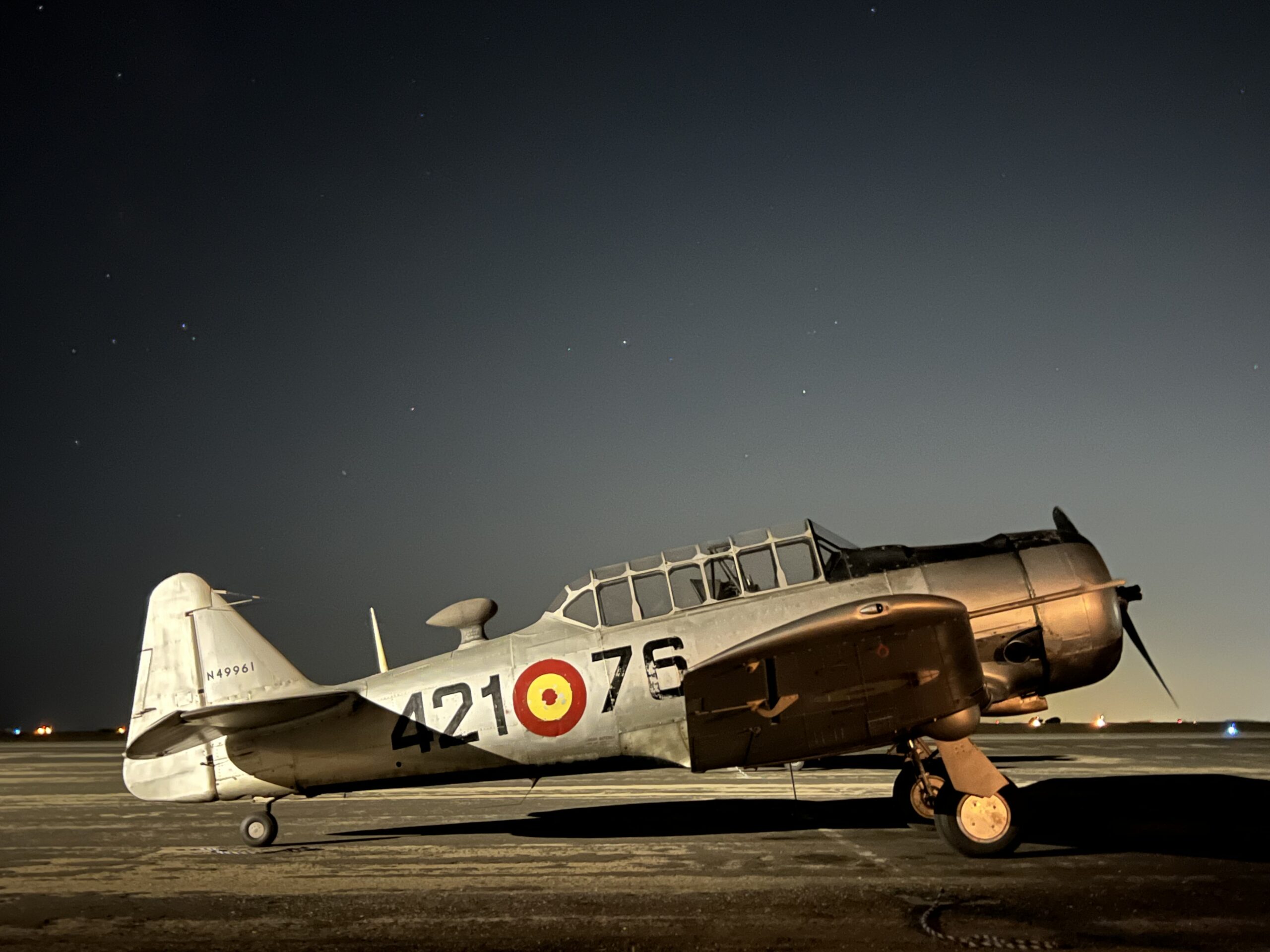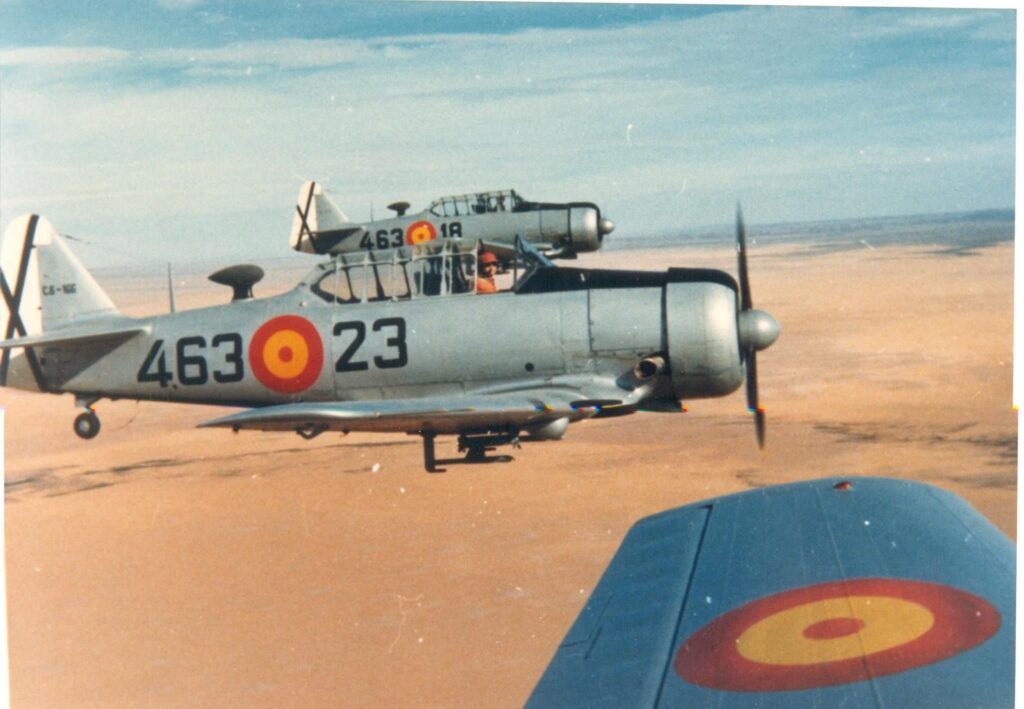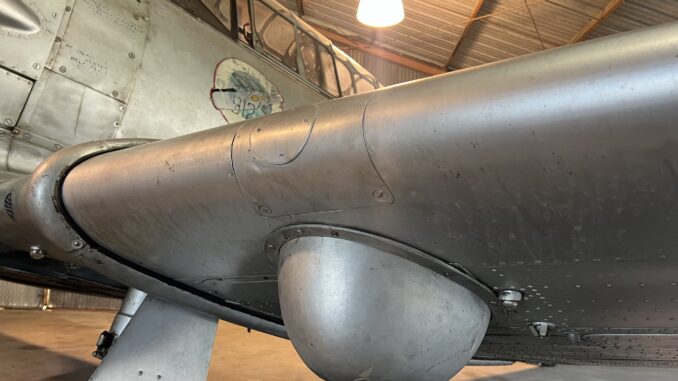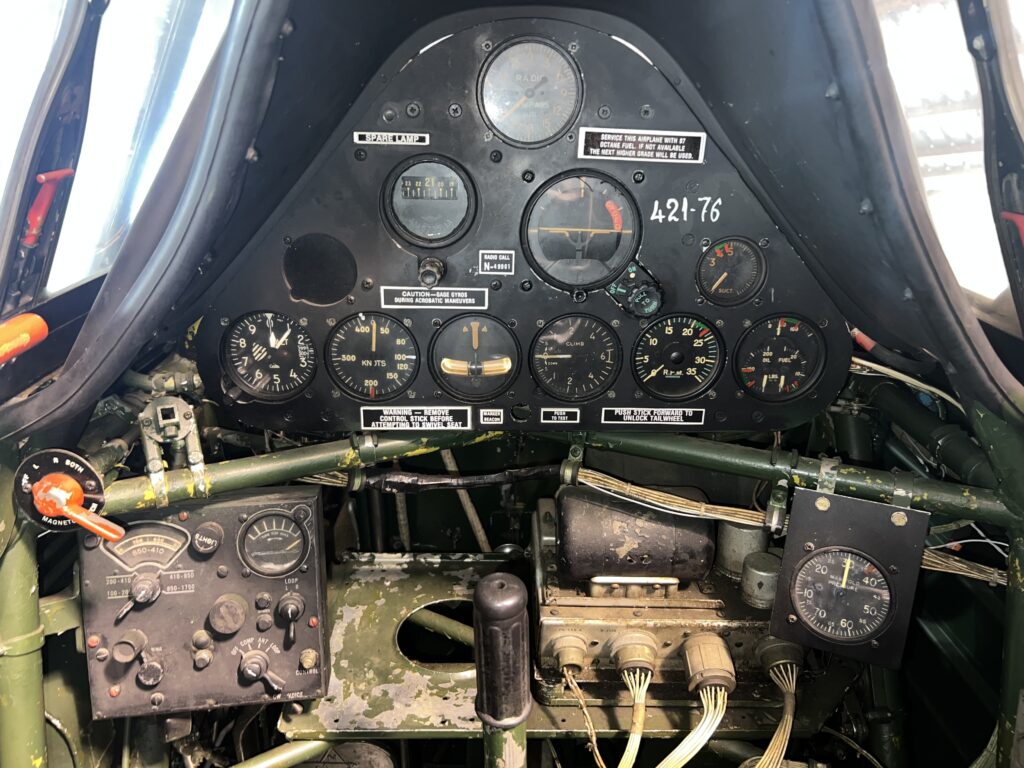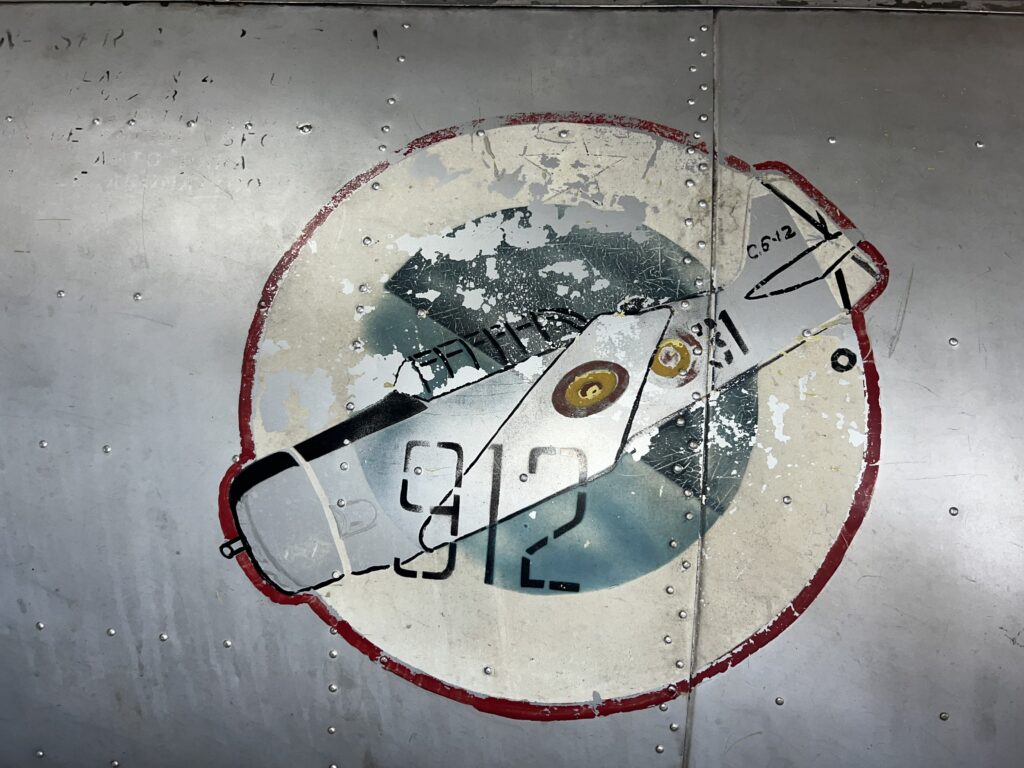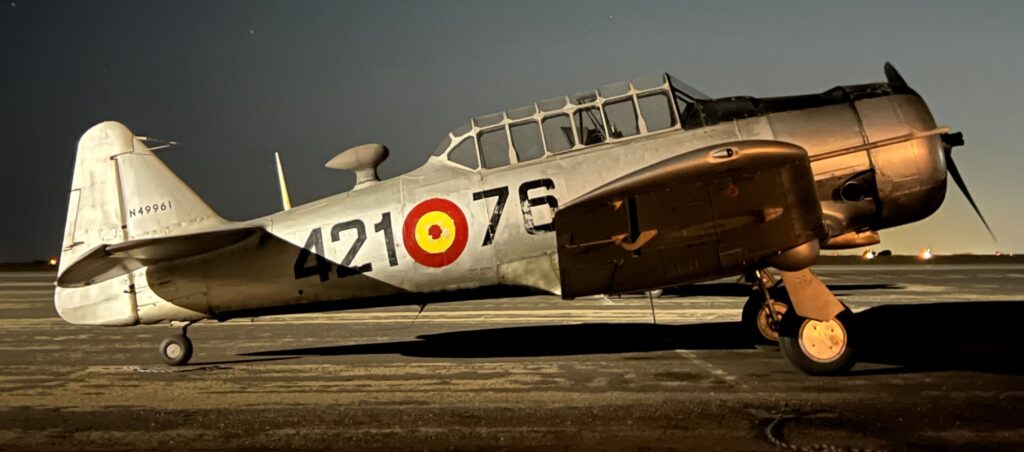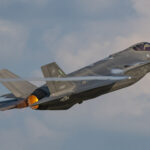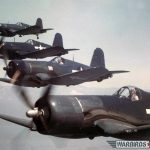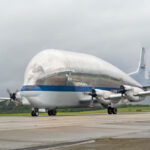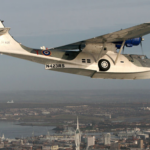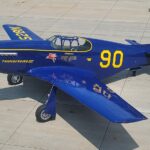By Angela Decker
Deep in the heart of Texas lies a historical gem that tells the story of two countries, two continents, and two pasts, with its original and historic livery and configuration. This AT-6D, owned by the Texas Warbird Museum, owned and operated by the Reiley family, is ready to take to the skies over the northern mid-west this week, as history takes flight and hits the “road” to Oshkosh. This specific T-6 will be making its first appearance at both Wings of the North in Eden Prairie, MN this weekend preceding AirVenture, and then at EAA’s AirVenture in Oshkosh, WI. With this year marking the 85th Anniversary of the North American T-6, it only seems fitting that this Spanish Lady should grace warbird fans with her presence at the epicenter of aviation enthusiasts.
Much like Spain itself, La Dama Española(The Spanish Lady) T-6 has an exotic and colorful history, tempered by a touch of mystery. She was produced in Dallas, Texas on July 17th, 1944, and just celebrated her 79th birthday this week. Following the day she rolled off the production line is where that bit of mystery comes in from her past. She is known to have been part of the war effort in some capacity. Most T-6s were used for pilot training, gunnery training, towing targets, transporting, and other various tasks that made the T-6 the workhorse of WWII. However, the Reileys have not yet been able to find specific records that definitively determine how this future Spanish T-6 was utilized during its time with the United States military.
Following the end of WWII, the T-6 was still widely and actively utilized by the newly formed United States Air Force. In fact, versions of the T-6 served in various capacities during the Korean War in the 1950s, including as forward air control. This Spanish T-6 is believed to have stayed on active duty, potentially training pilots for the United States Air Force or the Air National Guard. Records show that this T-6 was likely stricken from inventory in the U.S. and sold to the Spanish government in 1954 to be used in both training and combat. A T-6 in combat? That seems a bit unusual; however, this T-6 has specific attributes that show its combat history. Under the wings, she has gun blisters. Used to catch the empty rounds of ammo, this feature is obviously rather rare on a T-6. In addition to the gun blisters, it this lovely lady also has a bomb release lever inside the cockpit, an extremely rare find on a T-6.
The Spanish Air Force found the T-6 to be a very useful aircraft for combat missions. They saw the strength of the T-6, along with its ability to be agile at a slower speed to be an excellent fit for a ground attack aircraft for their Air Force. Utilized in a similar fashion as the A-10 Warthog today, their fleet of T-6s were used in Northern Africa, Morocco, and Guinea. The T-6 served the Ejército del Aire y del Espacio (Spanish Air Force) well, and it was not until June of 1982 that they retired their T-6 inventory. The T-6s remaining in inventory at that time were either sold to collectors or utilized for scrap metal. Fortunately, for The Spanish Lady, she was saved from the scrap heap and imported back to the United States.
This particular T-6 only had one owner between its time in the Spanish Air Force and its current home with the Texas Warbird Museum. It spent the last 40 years tucked away at a private airstrip in Georgia. It was owned by an older gentleman who would take her out for a spin a couple of times a week to keep the aircraft and his abilities current. While most T-6s sold off by the Spanish Air Force and imported back into the U.S. were repainted to an “American” warbird livery, this owner opted to keep the livery and configuration the same as when it was in service in Spain. That singular decision to leave this airframe as a literal capsule of its history actually gave this T-6 a brighter future. Its ability to tell a story and create living history that can be touched and seen by the public is exactly what the Reilyes were looking for when they purchased the Spanish T-6.
The Reileys had been searching for a T-6 to purchase for some time. But as fate would have it, every time they would go on a journey expecting to come home with at T-6, they would return with a different warbird. Before purchasing the T-6, they acquired a Vultee B-13 and a North American T-28A Trojan. Both aircraft were purchased on the road to the perfect T-6. And in August of 2022, it seemed that the yellow brick road had finally led them to Oz when they found this T-6 up for sale. Their immediate concern was the gun ports and the nose gun and whether or not they would find corrosion in those areas. Many T-6s that had gun placements eventually developed corrosion from the gunpowder use, especially around the compartments in the wings. Much to their delight, upon inspection there was no corrosion In fact, those areas almost appeared like new.
The fact that this airframe also proved to be historically configured and the paint scheme authentic, were definite factors in the acquisition. In fact, the paint scheme is the original paint from its combat days in Spain. The paint might appear to have scratches, blotches, chips, and fading, but the Reileys feel this more accurately tells the story of this T-6 and the history of the Spanish T-6s. The markings themselves were hand-painted with precision. “One of my favorite markings on our T-6 is the very rare 912 Squadron markings located just below the front cockpit on the fuselage. Again, this marking was put on by a steady hand and paintbrush with the 912 squadron, which was one of their most successful combat squadrons”, said Hunter Reiley. Not only is the paint scheme fully original, the cockpit is still configured with all of its original radios and equipment. Should you choose to reference the WWII Pilot Operating Handbook for this version, you would find the cockpit layout to be identical. It’s a true time capsule.
La Dama Española (The Spanish Lady) will be flying into AirVenture in Oshkosh with a mission to encourage people to engage with history. The Reiley family can often be found at events and fly-ins with a line of people waiting to see their aircraft, as they enjoy engaging with the public and passing on the history of these lovely warbirds. Flying and sharing history is a family affair. Both Jeremy Reiley, father, and Hunter Reiley, son, are experienced pilots, with Devyn Reiley, wife of Hunter, a newly minted T-6 pilot. So, look to the skies over Oshkosh for this beauty as she takes to the skies throughout the week. You can encounter the Spanish T-6 for yourself parked in the T-6 line-up in the Warbirds area of AirVenture. Be sure to ask them about her history, check out the hand-painted 912 Squadron markings on the fuselage, grab a photo or two of this lovely and authentic lady, and follow the Texas Warbird Museum as they seek to share history with the next generation!
Update – 8/1/23:
Tragically, this T-6 was involved in an incident during EAA AirVenture in Oshkosh, WI on Saturday, July 29, 2023. Shortly after takeoff the aircraft crashed into Lake Winnebego. Devyn Reiley, pilot, and a passenger, perished in during the crash. Devyn was a vivacious, adventurer who loved aviation and loved sharing her passion with others. A Live Like Devyn Memorial Scholarship fund is being set up in her honor. To support that scholarship fund, please follow here: https://www.facebook.com/profile.php?id=100095387678348







